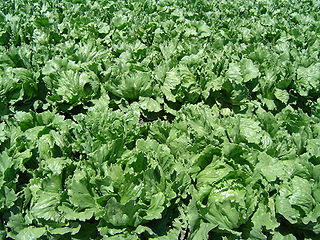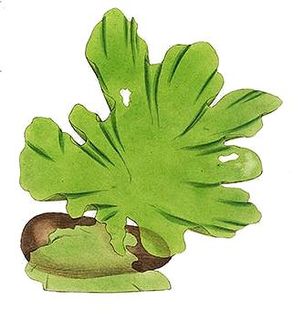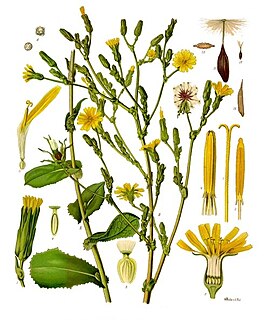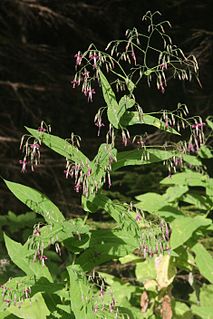
Lettuce is an annual plant of the daisy family, Asteraceae. It is most often grown as a leaf vegetable, but sometimes for its stem and seeds. Lettuce is most often used for salads, although it is also seen in other kinds of food, such as soups, sandwiches and wraps; it can also be grilled. One variety, the celtuce, is grown for its stems, which are eaten either raw or cooked. In addition to its main use as a leafy green, it has also gathered religious and medicinal significance over centuries of human consumption. Europe and North America originally dominated the market for lettuce, but by the late 20th century the consumption of lettuce had spread throughout the world. As of 2017, world production of lettuce and chicory was 27 million tonnes, 56% of which came from China.

Lactuca, commonly known as lettuce, is a genus of flowering plants in the daisy family, Asteraceae. The genus includes at least 50 species, distributed worldwide, but mainly in temperate Eurasia.
Lactucarium is the milky fluid secreted by several species of lettuce, especially Lactuca virosa, usually from the base of the stems. It is known as lettuce opium because of its sedative and analgesic properties. It has also been reported to promote a mild sensation of euphoria. Because it is a latex, lactucarium physically resembles opium, in that it is excreted as a white fluid and can be reduced to a thick smokable solid.

The sea lettuces comprise the genus Ulva, a group of edible green algae that is widely distributed along the coasts of the world's oceans. The type species within the genus Ulva is Ulva lactuca, lactuca being Latin for "lettuce". The genus also includes the species previously classified under the genus Enteromorpha, the former members of which are known under the common name green nori.

Lactuca virosa is a plant in the Lactuca (lettuce) genus, often ingested for its mild analgesic and sedative effects. It is related to common lettuce, and is often called wild lettuce, bitter lettuce, laitue vireuse, opium lettuce, poisonous lettuce, tall lettuce, great lettuce or rakutu-karyumu-so.

Lactuca serriola, also called prickly lettuce, milk thistle, compass plant, and scarole, is an annual or biennial plant in the dandelion tribe within the daisy family. It has a slightly fetid odor and is commonly considered a weed of orchards, roadsides and field crops. It is the closest wild relative of cultivated lettuce.

Prenanthes is a genus of plant in the family Asteraceae, often referred to as rattlesnake root.
Wild lettuce is a common name for several lactucarium-containing plants related to lettuce. The name most often refers to Lactuca virosa, though it may also refer to:
Tall lettuce is a common name for several plants related to lettuce and may refer to:

Lactuca canadensis is a species of wild lettuce known by the common names Canada lettuce, Canada wild lettuce, tall lettuce, and Florida blue lettuce. Its true native range is not clear, but it is considered to be a native of the eastern and central parts of North America. It naturalized in the western part of the continent as well as in Eurasia.

Lactuca saligna is a species of wild lettuce known by the common name willowleaf lettuce, and least lettuce. It is native to Eurasia but it grows in many other places as an introduced species, including much of North America.

Nabalus is a genus of Asian and North American flowering plants in the dandelion tribe within the daisy family.
Lettuce is a leafy vegetable. The name is also applied to other related and unrelated plants. Including the leafy vegetable these are

China is the world leader in lettuce production, producing half of the world's lettuce. Stem lettuce is grown in the country and the stems are prepared as a cooked vegetable. According to estimates given by the Food and Agriculture Organization (FAO) in 2006, China produced around 11,005,000 metric tonnes of lettuce on 500,250 hectares of land. In 2010, the FAO reported that some 12,574,500 tonnes of lettuce were produced during that year. Taiwan is also a producer of good quality head lettuce, which is an export commodity.
Lactuca cypria, Cyprus lettuce, is a biennial, erect herb with glandular, hairy stems and a globose rhizome. Leaves alternate, simple, the basal large, oblong, petiolate, 10-15 x 5–7 cm, pinnatisect with a suborbicular terminal lobe, the upper smaller, often with a profound purple colour at the lower surface. Flowers in heads, capitula in corymbs, florets pale yellow, all ligulate, flowers April–July, fruit a pappose achene.
Blue lettuce, wild blue lettuce, or common blue lettuce can refer to:
Lactuca ludoviciana, the biannual lettuce, is a North American species of wild lettuce. It is widespread across much of central and western Canada and the western and central United States from Ontario west to British Columbia and south to Louisiana, Texas, and California. Most of the known populations are on the Great Plains; populations west of there may well represent naturalizations.

Lactuca quercina is a species of wild lettuce native to Europe and Asia. It is an annual or biennial herb in the dandelion tribe within the daisy family growing from a taproot to maximum heights of 50–200 cm (19.5–78.5 in) or more.
Lactuca aculeata is a species of wild lettuce native to Anatolia, the Levant, Iraq and Iran. A very prickly plant, it is closely related to Lactuca serriola and Lactuca sativa, and can readily interbreed with them. It is possible that Lactuca aculeata contributed to the gene pool of cultivated lettuce.
Lactuca watsoniana, locally known as alfacinha, is a species of wild lettuce endemic to the Azores. An endangered species, there are fewer than 2000 individuals remaining in the wild. DNA evidence shows that it is closely related to the North American species of Lactuca, while the Canary Islands endemic Lactuca palmensis is more closely related to African and European Lactuca lineage.










